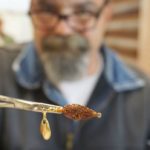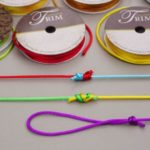
There are hidden treasures inside craft stores
Don Lawler of Shreveport is a man on a mission. His mission? To scour craft stores, dollar stores, hardware stores for materials to use for his next great fly.
So far his track record speaks for itself. The nationally-renown tier has created numerous innovative patterns using unique materials not found in traditional fly shops.
For example, one of his best-known creations is the Infused Spoon Fly. He mixes epoxy and infuses bits of reflective material from some item found at a hobby or party store. A hook is placed into a metal form created from soft drink cans, and the mixture is poured into the form.
Once hardened, the spoon fly is popped out of the form. Many redfish have been taken with these flies.
While Lawler’s passion for craft and dollar store items wasn’t born of necessity, for some tiers it is. For those living in small towns and rural areas, these stores represent the only local source of materials such as feathers, beads, and chenille.
And while the Internet makes it possible to shop online, there’s no denying the thrill of searching the aisles of a store and letting your imagination conjure up the endless possibilities.
Even for practical applications, there are a number of flies that require a trip to the hobby or hardware store.
Take foil pencil poppers, for example. For these, you need balsa wood, colored foil paper, rubber cement and acrylic paint. The body is made from a cylinder of balsa wood. The foil paper is bonded to the balsa cylinder using rubber cement. All these items can be found at craft stores.
Even poppers made from preformed Styrofoam bodies — as sold in shops — must be painted. In many cases, they’re airbrushed. Guess where we get our airbrush supplies?
And whatever your popper is made of, it needs a clear and waterproof protective coat to last through many bites of bream, bass, redfish, or speckled trout. Two of the best epoxies are Liquid Fusion (found at craft stores) and Devcon 2-Ton Epoxy (found at hardware stores).
When Randy Leonpacher of Baton Rouge created the now world-famous Jitterbee, he faced a dilemma. The fly was tied on an Eagle Claw 080 baitholder hook. The largest “fly” bead at the time couldn’t fit over the 3x heavy size 8 hook.
So Leonpacher went to Hobby Lobby and found 4 millimeter beads that worked just fine. Soon after, he began using the gold plated beads as they held up to corrosion longer.
While tying suppliers like Umpqua and Wapsi now make larger beads that fit the Jitterbee, Leonpacher continues to use the original source. “Why mess with success?” he reasons.
Several other famous flies owe their origin to craft materials.
One is the Foam Spider. This popular bluegill fly consists entirely of foam sheeting and rubber legs. The foam is cut in strips, then tied in folded over the legs.
Another is the Hackberry Hammer created by Bryant Smith of Lake Charles. It uses Christmas tinsel as the wing and underwing, with an ice chenille body. All of this is tied to a long saltwater hook.
While craft stores may be a popular destination for fly tiers, it’s also home to one of the best educational items that beginner fly anglers can own — mouse tail cord.
Knots are a critical component to fly fishing. The variety of knots can vary, whether it’s building leaders, attaching leaders to fly line, or attaching flies to the leader, and will depend on whether the application is coldwater, warmwater, saltwater, or offshore.
Many years ago, our club in Baton Rouge was planning their first “Fly Fishing 101” workshop. It was suggested we use colored string to demonstrate knots, as opposed to monofilament.
I happened to be at one of the local craft stores. I asked the lady in fabrics where I could find colored string. I told her what it was going to be used for.
The lady pointed me over to a rack with spools of mouse tail cord. Also known as decorative trim, this 1/8-inch round nylon material comes in over two dozen colors. Furthermore, it compresses very little, making it ideal for simulating fluorocarbon knots.
When you tie knots with mouse tail cord, you can easily see how they take shape. It’s also a lot easier to examine the completed knot and determine if it was tied correctly.
Later I learned that students who practice knots extensively with sighted materials more quickly transition to the thinner and less visible monofilament. It’s as if the mind records each knot-tying process and repeats it without the angler giving much thought to the process.
Whatever your need, adventure awaits at your local craft store.




